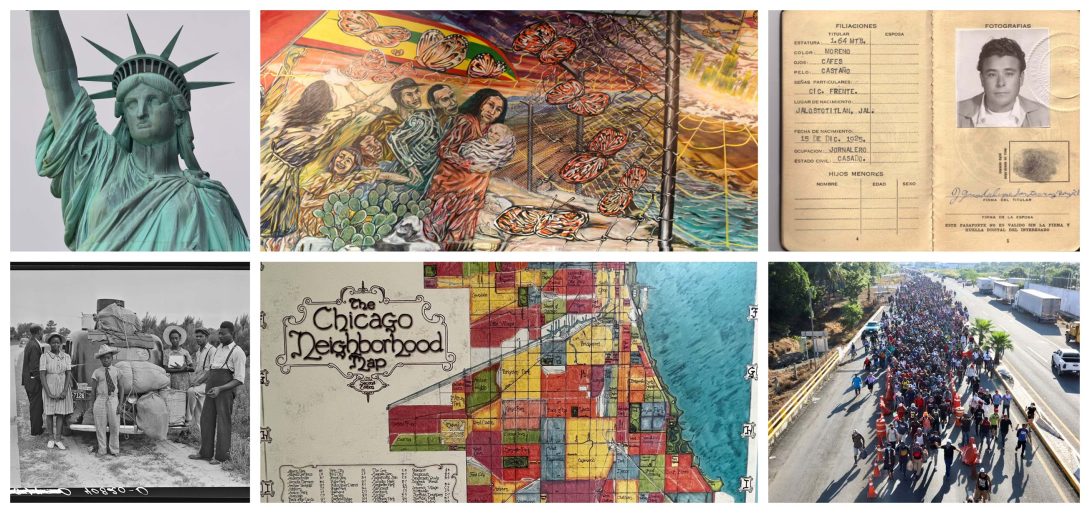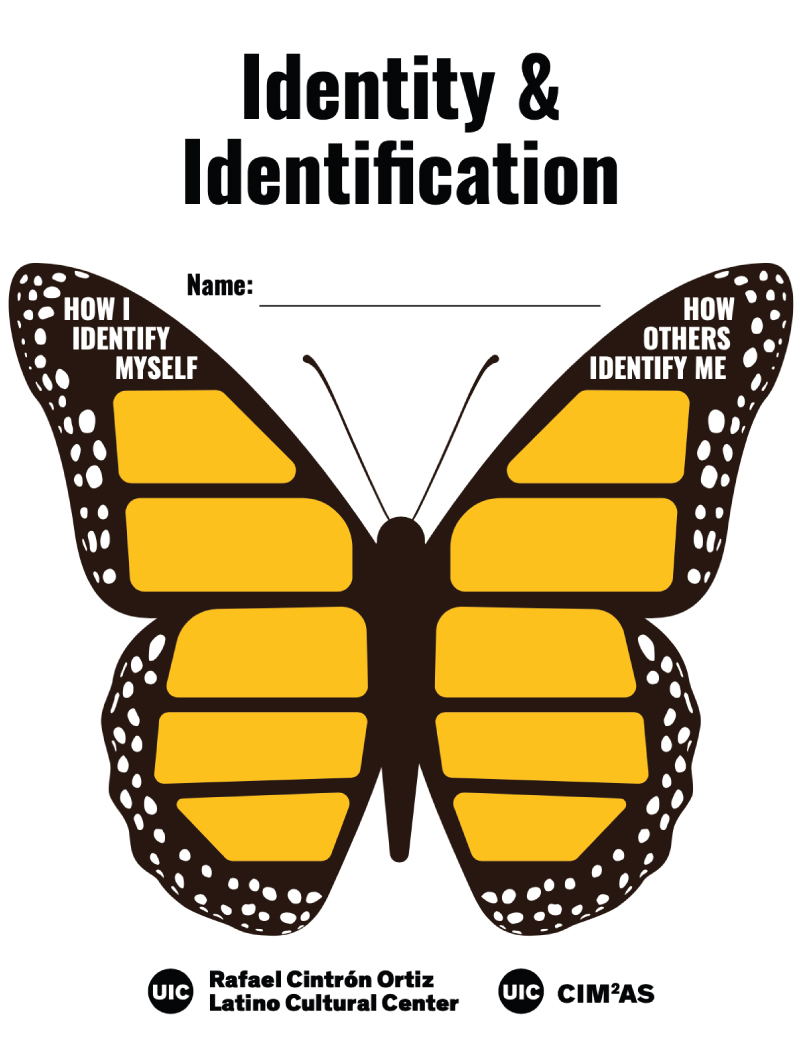Journeys of Transformation
Themes: Issues of (im)migration, identity, personal journeys, race, and diversity/equity.
line

Activity 1: Im(Migration Collage)
At the LCC, we use immigration and migration to be more inclusive of the variety of experiences that people may have had moving around to meet their particular needs. Immigration is used a lot in the media and policy, it might refer to people who have moved once, crossing international borders. Migration might be used for a variety of movements, like in the natural world with birds and butterflies, or for people who move within national borders from rural to urban areas, between cities, towns, and neighborhoods. We also note that not all people have had the same agency or freedom of choice in their movement and thus our personal, family, or community experiences may differ.
In this activity, we have pieced together an (Im)migration Collage that includes historical and contemporary images representing various (im)migrant experiences. Examples of historical images may include Ellis Island, the Bracero Program, The Great Migration, etc. Examples of contemporary images may include neighborhoods, cities, etc. to be more inclusive of moving experiences.
As students are presented with the (Im)migration Collage, we ask them to review the collage and to focus their attention on one image as they self-reflect and answer the following questions:
- What image represents immigration or migration to you in some way and why?
- What image reminds you of your family or someone you know and why?
Additional probing questions:
- What does the American Dream mean to you?
- Is there anything (situation/event) that changed the way you saw (im)migration?
- How is our country shaped by immigration? (benefits, detriments?)
- What does citizenship mean to you? What could it mean?
- What are the greatest misperceptions about immigration?
- What are the biggest challenges, issues, or crises happening right now in regards to immigration?
- Is the U.S.A immigration system fair? Why or why not?
- What American values inform our laws? How has that changed over time? What values should inform our laws?
Educator’s Note
(Im)migration can feel like a weighty topic as cultural and social backgrounds also play a big role in shaping attitudes and beliefs about immigration and migration. However, most people have a connection to this issue, whether through personal heritage, friends or loved ones, or simply through the labor that supports our everyday American consumption. Additionally, there are many concerns we share across the spectrum of political and cultural groups. This activity invites the sharing of personal stories, which can further elicit conversation on race, diversity/equity and personal/social identities.
activity 1

Images Note
Some of our images were selected from the Library of Congress, Getty Images, and Wellcome Collection websites where you can find more images to create your own collage that may be more appropriate for your classroom. Other than historical and contemporary images, students can also be presented with a material collection including a passport, a bus or train ticket, an image of a monarch, a mural depicting (im)migration, and more.
line

Activity 2: Monarch Butterfly Migration
Part A: Choose Your Own Adventure
In this activity, students choose their own adventure in this informative and interactive journey to learn more about the monarch butterfly and its migration. The goal of the Monarch Adventure activity is for students to learn about the monarch’s migration, population threats, and climate change connections in a unique and engaging way.
Educators can engage students as they make their way through the Monarch Adventure in one of two ways: (1) via an online tool or (2) using the provided script for an in-person activity. Students will attempt to survive the migration season by making different choices along the path while reflecting on the monarch’s journey.
The online tool is a Google Form that students can fill out on their own. While the full script to lead the in-person option requires the instructor to moderate the interactive activity. Both of these tools can be found at latinocultural.uic.edu/programs/gbp/cimas.
Synthesize Activity: Once activity is completed, educators can review decisions made and
why each output happened, highlighting the causes of death and threats against the monarch butterfly population.
Educators note

Educator’s Note
Because of the monarch butterfly’s unique migration, it is one of the best tools to attract people to learn more about conservation. Its cultural symbolism has been especially important in creating dialogues in Mexican-American communities, allowing people to participate in international-level conservation projects. Immigrant communities serve as significant sources of knowledge on plants in the Chicago Region, and many of the immigrants that now reside in Chicago can recall seeing monarchs or birds on both sides of the flyway, making their contributions very important to environmental conservation. Therefore, in addition to inspiring environmental and climate action, monarch conservation can help spark conversations about cultural understanding and social justice.
Part b
Part B: Monarch Zine
Monarchs undergo an amazing metamorphosis, changing from a small egg into a beautiful butterfly. Thus, parallels can be drawn between the life events of the monarch butterfly and our own lives. This Monarch Zine activity will help students learn more about the monarch butterfly biology while also exploring the connection between nature and people.
In this activity, students will create a miniature zine in which each page represents the life stage of the monarch butterfly. For each stage, students will reflect and draw comparisons between their own life stages.
Reflective questions for each stage:
- Egg: Where were you born? What is your cultural heritage? Where is your family from?
- Larval stages (1-5 instars): What were your key turning points in life? Things that were significant, caused great change, or caused you to swerve?
- Pupa: What is your metamorphosis? What is the change and transformation you need?
- Butterfly: What is a future goal that you envision for yourself? What skills, values, and knowledge has your family passed down from generation to generation?
Educator’s Note
Students’ life stages will differ from person to person; therefore, allow students to share as much of their personal journeys as they would like while encouraging them to be vulnerable with one another.
Activity Note
Students can use the template provided or create their own zine from scratch using available art materials. After creating their individual zine in small groups, students are asked to share and discuss their work.
line

Activity 3: Monarch & Social Identity Worksheet
This Monarch & Social Identity worksheet can help students consider intersectional identities, by writing 5 words for their personal identities (how they describe/view themselves), and 5 words others might use to describe them (how others might perceive them). Encourage students to think about social categories and characteristics while reminding them that it is alright if some identities are the same between both circles and/or if some are different.
Social categories to consider: Sex, Gender, Sexual Orientation, Race, Ethnicity, Immigration Status, Age, Ability, Socio-Economic Class, Religion, etc.
Examples: Woman, Teacher, Catholic, Black, Veteran, Scientist, Queer, Intimidating, Only child, Beautiful, Daughter, Working-class, First generation in higher education, Person with a disability.
Show them an example of a filled out worksheet (complete one yourself!)
- Hand out identity worksheet and explain activity.
- Instruct students to take two minutes to fill out the worksheet.
- Invite them to consider first: If you had to pick one identity that you’d describe yourself as most often, which might it be?
- Next pick one that you think the outside world sees first.
Reflect: How was this activity? Were there any similarities or differences between the outside and personal identity descriptors? Can anyone share a time in your life when one of these descriptors worked to your advantage? Disadvantage?
sheet

Educator’s Note
This worksheet helps students recognize intersectional identities. Sometimes people of color have less agency in describing themselves as they would like (ex. teacher, scientist) and more often by skin color or negative stereotypes (ex. dangerous, dirty). Sometimes identities that are disadvantages in certain circumstances are advantages in others (ex. male-identified person is viewed as dangerous by the police, but more competent than female colleagues by a boss). We all have some privilege, but we also have barriers to overcome, and we can use our privilege to help others and find support to overcome challenges. This activity helps students to recognize that they are not limited to the stereotypes or expectations of others, but also have agency in defining themselves.
Definition: Intersectionality
The way in which multiple identities or issues come together to form a social reality is known as intersectionality. Intersectionality recognizes that we are made up of different identities that influence each other, though some might be more evident or dominant. For instance, a Latinx woman may experience gender discrimination for being a woman, but at the same time also experience racism for identifying as Latinx.
Intersectionality also works in positive ways, where one’s identities might be perceived as advantages; putting one in a position of connectivity or creativity. Our identities might also lend privilege or agency. For example, while that same Latinx woman might experience discrimination, she might have other benefits by belonging to the middle class, being a U.S. citizen, or being light-skinned. Regardless of our identities, intersectionality recognizes the complexity within each person and beyond in our diverse society.
